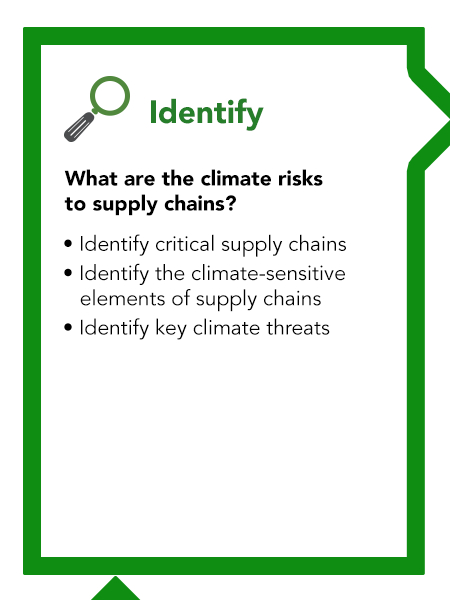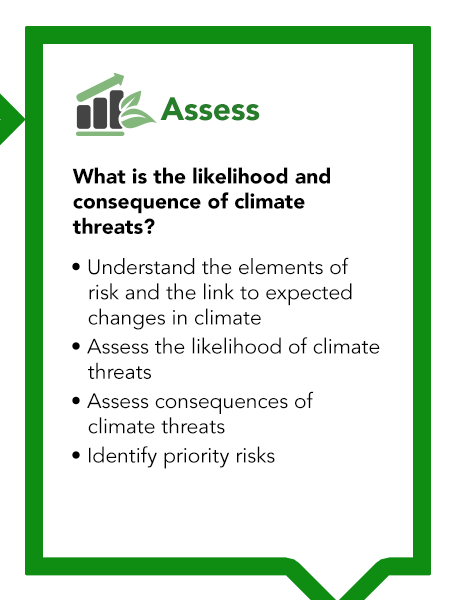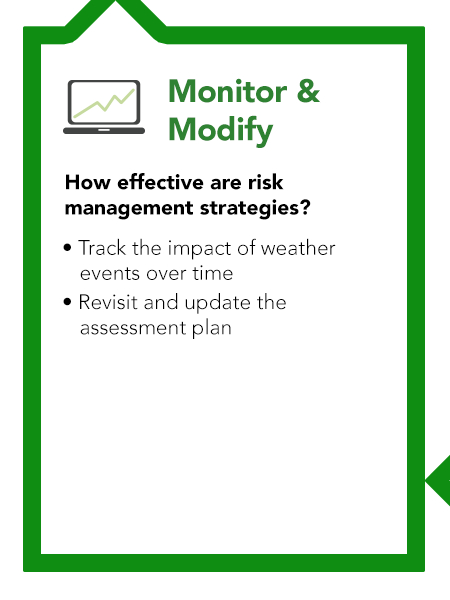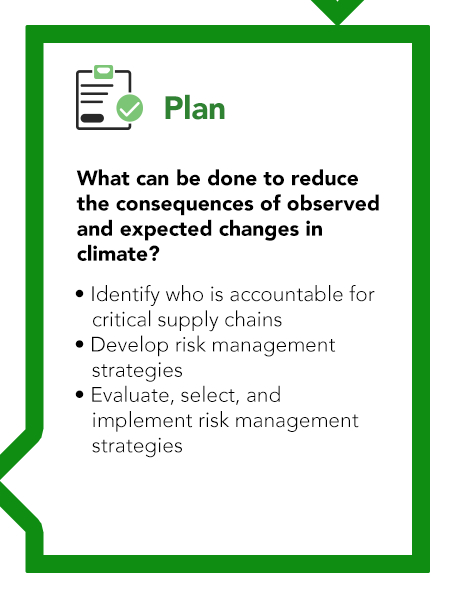Supply Chain Climate Risk Management Framework
Use this framework to gain a better understanding of how climate and weather-related impacts can disrupt supply chains, as well as how agencies can cover observed and expected climate related risks in their supply chain risk management processes. Throughout the framework, take advantage of publications, methodologies, and tools available to your agency that can enrich your analysis.
This framework assumes that you will walk through each of the steps for one critical supply chain at a time. If it is useful to assess risk for multiple supply chains, the steps could be followed multiple times for each supply chain or it may be useful to consider different supply chains simultaneously (especially when gathering climate data that would be relevant to more than one supply chain).
Use the companion workbook , a user-friendly Excel file, to document and organize information on climate risks as you work through the framework. The workbook assumes that you are referring to this framework as you fill in information. Refer to examples in the companion workbook to help you understand the objective of the workbook, the types of information you should be collecting and recording, and the outputs of the companion workbook.
, a user-friendly Excel file, to document and organize information on climate risks as you work through the framework. The workbook assumes that you are referring to this framework as you fill in information. Refer to examples in the companion workbook to help you understand the objective of the workbook, the types of information you should be collecting and recording, and the outputs of the companion workbook.
The framework (shown below) includes four steps to manage climate impacts on supply chains:
- Identify: What Are the Climate Risks to Critical Supply Chains?
- Assess: What is the Likelihood and Consequence of Climate Threats?
- Plan: What Can Be Done to Reduce the Consequences of Climate Risk?
- Monitor and Modify: How Effective Are the Risk Management Strategies?
These steps should align closely with existing risk management protocols.
The audience for this framework is multidisciplinary and includes GSA customers involved in procuring goods and services as well as those within federal agencies who work to maintain operations through irregular events and disruptions. While one person or a small group of people may be leading this process, below is a list of stakeholders who may be consulted at certain stages of the framework. This list is not meant to be exhaustive but rather provide illustrative examples of the types of people who it may be beneficial to consult. Individual supply chain consultation needs will vary.
| Stakeholder | Expertise |
| Acquisition offices |
Establishment of contracting vehicles for acquiring goods and services |
| Budgeting offices |
Financial impacts to operations from supply chain disruptions
Budgetary options for adaptive management |
| Continuity of Operations (COOP) managers and emergency management staff |
Emergency risk management procedures for supply chains and agency operations |
| Environmental policy staff |
Climate and environmental impact expertise |
| External consultants |
Climate expertise (tailoring climate data to agency needs, conducting a vulnerability assessment, etc.)
Supply chain risk management strategies |
| Facilities maintenance and operations staff |
Product and service usage, importance to agency objectives
Risk management strategies |
| Fleet managers |
Vehicle asset management strategies, asset importance to supply chain objectives |
| Information and Communications Technology (ICT) managers within the Federal family or suppliers |
ICT asset and systems management and risk management capabilities |
| Original Equipment Manufacturers (OEM), resellers, and service providers |
Insight into product or service primary sources and manufacturing processes |
| Planning offices |
Short- and long-term supply chain planning (both past and future) |
It is not a comprehensive explanation on supply chain risk management. It is assumed that you have a solid understanding of supply chain management and current agency supply chain management practices, so this framework focuses on how climate risks can be factored into those existing processes. The framework does not provide background information on supply chain risk management practices other than as they pertain to climate readiness.
It is not a detailed technical guidance for conducting an agency-specific risk assessment. This is a high level conceptual framework that is flexible enough to be used by any Federal agency for any critical supply chain.
Supply chain climate risk management framework
Content developed by the the Office of Acquisition Management, Federal Acquisition Service, General Services Administration.
![]() , a user-friendly Excel file, to document and organize information on climate risks as you work through the framework. The workbook assumes that you are referring to this framework as you fill in information. Refer to examples in the companion workbook to help you understand the objective of the workbook, the types of information you should be collecting and recording, and the outputs of the companion workbook.
, a user-friendly Excel file, to document and organize information on climate risks as you work through the framework. The workbook assumes that you are referring to this framework as you fill in information. Refer to examples in the companion workbook to help you understand the objective of the workbook, the types of information you should be collecting and recording, and the outputs of the companion workbook.




